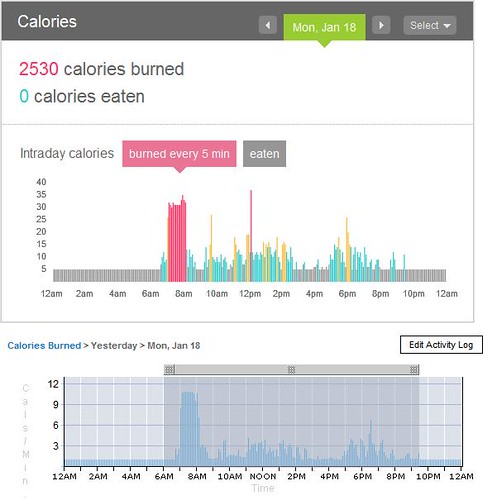<< Previous Round bodybugg vs fitbit: Round 3 – Sleep Tracking
So the reason I was initially drawn to the bodybugg was that it allowed me to see how many calories I was burning in a day. I knew how many calories I was eating. What I didn’t know, was how many I was burning; but why is that even important?
Weight loss is a simple equation of consuming fewer calories than your body burns. There are TONS of food logging websites & tools, and as I mentioned, I knew what I was eating, because I was logging my food for years prior to knowing about the bodybugg. But eating is only half of the equation in weight loss and weight management. I can tell you that if you eat 500 fewer Calories per day than your body needs, you will lose 1 pound per week; I already knew that. But how do you know how many calories your body needs?
What often happens with folks is that when they decide to lose a few unwanted pounds, they deprive themselves of foods with substance & eat "diet food" or "rabbit food" & at the same time, they might even start to exercise. What inevitably happens, is that they create too much of a calorie deficit. One of the symptoms of having too great of a deficit are feeling sluggish because there’s not enough energy to fuel workouts, and daily activity. And that doesn’t make a person feel good, or motivated to continue. After repeated large deficits, other things that may occur could be either a binge or a plateau; and those two events surely will lead to a relapse & old eating and lifestyle behaviors.
By knowing how many calories your body burns on a daily basis, you can reduce the number of calories consumed just enough so that you have a deficit & will lose weight, but not so many that you’re hungry or not able to perform daily activities.
What’s interesting is that when you read the value proposition statements from each company, fitbit doesn’t answer the "why?" Why do I want to use this product?
Fitbit
The Fitbit accurately tracks your calories burned, steps taken, distance traveled and sleep quality. The Fitbit contains a 3D motion sensor like the one found in the Nintendo Wii. The Fitbit tracks your motion in three dimensions and converts this into useful information about your daily activities.
Bodybugg
Find out how many calories you burn with the revolutionary new bodybugg armband. Use the web-based program to track calories in and calories out so that you can stay in control of your weight. Get the coaching and support you need to be successful from a fitness professional or personal trainer.
Maybe that’s not important to you. You’ve already connected the dots. But it will all come together when you look at how each of the parts interact with one another in my last blog post in this series. How the company views itself and how it differentiates itself from the myraid of weight loss aids on the market is the path in which the product is based.
Activity Display

So, here are two graphs of my activity for the same day. You can see that they mirror each other pretty well. Each bar on the fitbit’s activity graph represents 5 minutes of activity where the bodybugg represents 6 minutes. What doesn’t really make a lot of sense though is the fitbit’s vertical axis. The numbers represent the total for every 5 minutes & this makes me do math. So where the fitbit shows that I burned 35 calories in 5 minutes, I need to figure out that it boils down to 7 calories per minute. No big deal, but slightly annoying.
Activity Breakdown

What I really do like though is the way that the fitbit has broken my activity down into 4 categories of effort: Sedentary, lightly active, fairly active & very active. Not only is it represented in the activity graph above, but then they also put it into a pie chart (and who doesn’t like a pie chart?) so that I can see where I need to add more activity.
The bodybugg simply measures activity, which ends up being any movement or effort that registers more than 4.5 METs (read about METs). Registering activity is good, but breaking it down into vigorous versus moderate would be better. It allows users to better self-monitor.
If I have 2 clients & they’re both exercising for 45 minutes per day, but one is running & the other is walking, they can clearly see how their effort is going to impact their results. Just a little more effort can make huge gains in progress when it comes to weight.
Accuracy
It’s human nature to lie to ourselves. How many times have you heard yourself say "oh – it was just a little bite …" or "I must have burned a million calories!" We consistently overestimate the number of calories we eat, and underestimate the number of calories we burn. We think: "I just worked out, so I deserve to eat that cupcake." which is the whole premise of the TIME Magazine article titled: Why Exercise Won’t Make you Thin.
So, it’s crucial that the tool we use to tell us how many calories we’re burning is accurate. In my experience, the bodybugg is mostly accurate. I’ve been successful with it & many MANY of my clients have been truly successful too. No tool is 100% accurate at this point. What matters is that it’s close enough that it produces results. So what about the fitbit? The short answer is that it depends on what you’re doing in order to say whether the fitbit is accurate or not.
How It Works
The fitbit uses the same technology found in the Nintendo Wii. So basically, it’s a motion sensor. It’s pretty impressive that it’s as accurate as it is considering it’s based only on motion.
The bodybugg has 4 sensors: motion, skin temperature, skin perspiration, and air temperature. Between these four sensors, the bodybugg creates some sort of algorithm (magic & mirrors to me!) and is able to determine calorie burn.
Neither device is water submersible nor does each one work well with exercises that compromise the motion sensor (stationary biking, road biking, or roller-skating/blading to name a few examples). So, neither device is perfect.
Logging Activity
So, what do you do if you’re doing one of those activities or swimming?
The bodybugg allows you to add activities if it has detected off body time (off body time will be editable if the device is off for 30 minutes or more during user-defined waking hours).
The fitbit allows you to log activity any time during the day. Actually, I found this part a little weird. Although I really like the idea of being able to ‘correct’ inaccurate readings – like when I’m biking or skating, I also had to log my runs – even though it knew that I was performing vigorous activity. So, when I log my run, instead of burning 35 calories every 5 minutes, it jumped to 54 calories per minute. Additionally, I needed to know my running pace (which I don’t). When I guessed, it estimated that I burned an incredibly high number of calories! So, I had to futz with it.
Now, here’s where the fitbit really breaks down for me: Me futzing with it, is one thing, but a user who isn’t as aware of his/her level of effort, might really overestimate the number of calories that the activity truly burned. Because the bodybugg has 4 sensors & the fitbit only has one, in my opinion, it is a really smart pedometer.
One other piece that breaks down for me with the fitbit (and this goes for heart rate monitors too) is that neither consider body composition. Two women weighing 150 lbs can burn very different numbers based on body fat levels (30% versus 17%: the woman with lower bodyfat will burn more calories at rest and during exercise because she has a higher body composition of muscle). With the bodybugg, a user doesn’t have to know his/her bodyfat percent, but because the bodybugg has a body temperature sensor (muscle has a higher temperature than fat) it is accurate in spite of the user’s entered bodyfat percent.
Round 4 Winner
While the CDC estimates that 67% of Americans are either overweight or obese & 56% want to lose weight, I’m focusing on weight loss with the review of these tools, because in my experience, that’s what most people are looking to these tools to help them accomplish.
Accuracy is crucial when it comes to the success of these tools; Lots of folks are successful with losing weight, but not many have figured out how to maintain that weight loss. Accuracy is important because the tool shows exactly the number of calories a person needs to eat in order to maintain their weight loss and activity level. Because 95% of folks who lose weight, regain that lost weight, it shows us that as a nation, we’re alright on the losing part – where we need help is on the maintaining side. If I don’t know how many calories I’m burning, I don’t know how many calories I can eat in order to maintain my weight loss.
Although the fitbit activity graphing display is a little nicer, In my opinion, the bodybugg is the clear winner in this round.
|
bodybugg |
fitbit |
|
| Activity Display | win | |
| Accuracy | win | |
| Overall | win |

Elizabeth is a Master Certified Life and Health Coach with over 18 years of experience, dedicated to helping women in midlife thrive through holistic health and wellness. Her personal journey began with a desire to reduce her own breast cancer risk, which evolved into a mission to guide women through the complexities of midlife health, from hormonal changes to mental clarity and emotional resilience.
Elizabeth holds certifications from prestigious institutions such as The Life Coach School, Precision Nutrition, and the American Council on Exercise, as well as specialized training in Feminist Coaching and Women’s Hormonal Health. Her approach is deeply empathetic, blending her extensive knowledge with real-life experience to empower women in their 50s and 60s to build sustainable health habits that last a lifetime.
Recognized as a top voice in women’s health, Elizabeth speaks regularly on stages, podcasts, and webinars, inspiring women to embrace midlife with energy, confidence, and joy. Her passion is helping women regain control of their health, so they can fully engage in the things that matter most to them—whether that’s pursuing new passions, maintaining strong relationships, or simply feeling great in their own skin.